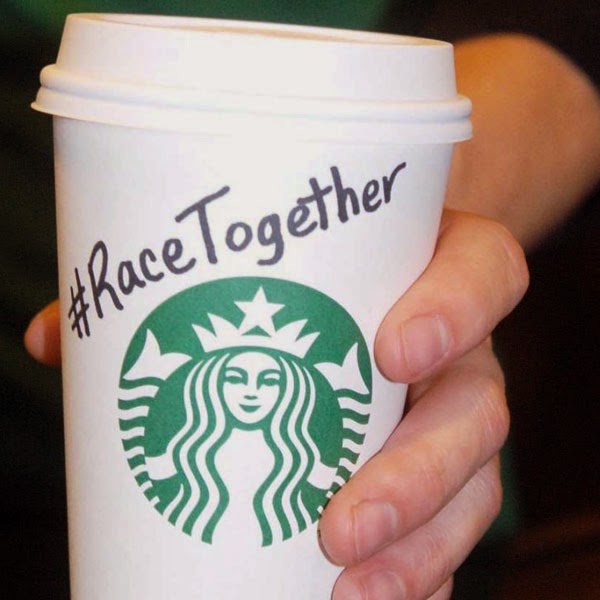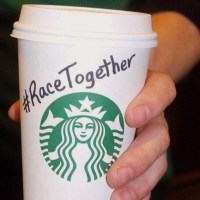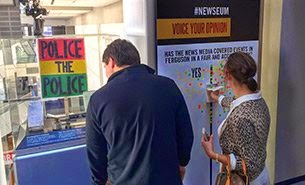Last weekend, Starbucks announced it will stop putting the slogan “Race Together” on coffee cups. Their spokesperson said this was a previously scheduled move, but to many it looked like a response to the flak the company has been taking over this initiative.
Race Together is the latest in a string of campaigns implemented by Starbucks CEO Howard Schultz, which have included
tuition reimbursement for workers, “Create Jobs” to raise money to fund loans to small businesses , and politely pushing back against open carry laws. Most recently Shultz announced “Onward for Opportunity,” funded by his family foundation, to train soldiers for civilian jobs, assisted by Starbucks and other corporate partners.
While there was some snarking about the earlier campaigns, Race Together provoked particularly virulent responses. The Twitterverse lit up with complaints from customers who didn’t want to be ambushed with a dialog about race before they’d ingested their morning caffeine (“honest to God, if you start to engage me in a race conversation before I’ve had my morning coffee, it will not end well.”), and from baristas being encouraged to initiate these discussions (““Being a barista is hard enough. Having to talk #RaceTogether with a woman in Lululemon pants while pouring pumpkin spice is just cruel.”). Snark aside, it is clear that many people on both sides of the counter felt deeply uncomfortable with this corporate prompt.
Given the swelling national discussion about race, power and prejudice (conscious or unconscious), why are so many people slamming the big S for tackling the issue? Particularly in a market shaped by Millennials, 89% of whom indicate they are more likely to buy from companies who support solutions to social issues? As a thoughtful article in the Economist points out, the pushback may stem in part from a perception that Starbucks is milking the issue to enhance its reputation (and profitability), but I think that the particular savageness of this response is due to a perceived lack of “authenticity” on the part of the company. As the Economist points out, when TOMS Shoes gives footwear to impoverished children it comes across as mission-related. Same for Dove’s Real Beauty campaign for healthy body image. So even if these efforts benefit the companies in question, they seem to be a natural fit—as were the earlier Starbucks initiatives. Fair trade coffee is directly related to their core business. Tuition reimbursement is tied to the welfare of their employees; Create Jobs to the well-being of their communities; Veteran job training to both. Even the “please don’t carry” request was positioned not as a statement for gun control (or against open carry laws) but as being about the comfort and well-being of customers. Race relations may seem like too big a leap, too far from the company’s legitimate areas of expertise or concern.
Which brings us to museums, and to #museumsrespondtoferguson—an informal network of museums and individuals (including a large cadre of tweeters and bloggers). Many museums, notably the Missouri History Museum and the Newseum, responded to the events in Ferguson with programs, panels, rapid response collecting, even of-the-moment modifications to exhibits. These responses were commendable and widely admired. I think these institutions were granted this respect because their actions come across as authentic—rooted in the their missions, relationship to their communities and to a history of serving in these ways. But I’m sure there are museums for which addressing race relations in America would be just as awkward a fit as it is for Starbucks.
I believe, deeply and fervently, that it is the moral and civic obligation of every nonprofit to make the world a better place. This requires staff to be attuned to the needs of their immediate community and the world, and to the organization’s mission, resources and capabilities. Collectively, museums can help heal countless wounds, large and small. For some museums this will mean tackling race relations, or climate change, or immigration reform through education or through activism. For other museums it may mean giving local homeless children a safe place to play, or feeding people hot soup while they discuss food issues impacting their communities. It might mean trying to prevent the extinction of non-human species by educating people about eating sustainable seafood or saving a local turtle. Or helping veterans heal from war-related trauma. And always, as AAM’s Museums and Community initiative emphasized, museums can facilitate community-driven conversations by making resources, like space, available for conversations and activism initiated by others.
But I get uncomfortable when high-profile coverage by the press results in pressure for all museums to address the headline issue of the day or week or month. It’s good to remind each other to stay alert to the needs of the world, to pay mindful attention to opportunities for our organization to help fill those needs. But I think we have to pay attention to the example of Starbucks, as well—museums have to act from an authentic place to be granted credibility and standing to weigh in. Otherwise, at best we risk using scarce time and resources to have no credible impact, and at worst we appear self-serving and naïve.
So, yes, please, #museumsrespond to all sorts of needs. But let’s divvy up the work, rather than all rushing to the same side of the boat. There is no lack of holes in the world that need patching, and we can each find ones we are best suited to mend.











There are certainly a number of challenges in identifying ways for the museum community to address issues like the deaths in Ferguson, Staten Island, Cleveland and elsewhere. I think one of the main ones is that while individuals working in museums may be anxious to be involved, museums, as incorporated entities, are more conservative and have major concerns about on how their actions will affect their audiences and funders. And while it is certainly true that museums have the potential to be community centers and places for the safe discussion of current events, this is something that is not yet part of most museum missions or of how the public generally views us.
I certainly don't have any clear ideas of how we deal with these challenges, but do have two thoughts. First, one of the things that museums do best is put things (objects, ideas, events) in context. Perhaps museums should not aim at being places of direct discussion, but offer programming and exhibits that add the understanding that comes from the longer historical view or through comparison to other places or cultures.
My second thought is that perhaps we should not expect the public to come to the museum, but that we should make sure that the museum is part of the public. Participation in public activities ranging from City Council meetings to service organizations like Kiwanis will making it clear that we are part of our larger community.
Thanks for this excellent and thoughtful post. You've raised so many good issues-authenticity of museum response, wider implications of social action by museums–hard to address in single comment but hope to address in future posts on Museumcommons
As a museum professional who teaches graduate students in museum education, I have had many discussions with my students about why it is in the best interest for museums to not shy away from controversial topics taking place within our communities. This topic has become more than simply theory and practice for me as I both live and work in the city of Ferguson, MO. I believe museums provide safe places for members of the community to come together and share ideas- even when they are difficult conversations. This practice of engaging the community in thoughtful, meaningful ways will not only bring people together, but it will enlighten us as professionals to the many voices and perspectives of the stakeholders in our communities.
A line that resonates deeply with me from your post is, "I believe, deeply and fervently, that it is the moral and civic obligation of every nonprofit to make the world a better place." Museums collectively have a civic mission. We serve a vital role in the communities in which we exist. Whether the focus of our individual institution is art, history, science, culture, etc…, the broader role we serve is as a space for the community to come together, to think through, to discuss, and to challenge ourselves and our communities. To share the great and terrible ideas, movements, people, artwork of the past, to ground us in where we've been so that we can better understand where we are going.
Thanks for this thought provoking post, and the reminder of our colelctive civic mission.
re #museumsrespondtoferguson Seems that much of the discussion has been less about responding to Ferguson and more about museum staff talking amongst themselves – not a bad thing, but seems tangential in some way to community engagement.
I often come back to the John Cotton Dana notion of asking the community what it is they want/need of the museum and then acting on that response – or in today's parlance – co-creation.
The museum I direct is located in a 95% Black community. As one of our regular community activities, we host a Black History Month event that is organized by the community. The museum provides the space and picks up the tab for the pizza lunch. In 2015, I had thought that this might be a good venue for #museumsrespondtofergusion, but the community wanted the theme to be Black Women Who Led the Way. The event featured talks by Black Vietnam era women veteran, a member of the Memphis 8 that desegregated Memphis State in the late 50s and a documentary on Shirley Chisolm's presidential bid in '72. Ferguson came up in a couple of the discussion points.
So, did our #museumrespondtoferguson or should we have been more adamant that the focus of the Black History month event be on #museumrespondtoferguson issue?
During the #museumsrespondtoferguson monthly chats, we've repeatedly emphasized that museums need to address internal structures that contribute to anti-blackness and racial inequity before engaging their communities.
These conversations are challenging but critical. More than anything else, action in this area (diversifying staff, widening collection focus, addressing oppression, etc.) will demonstrate authenticity and commitment to the communities they claim to serve and that museums are ready to do more than just pay lip service to diversity.
While it may seem like supporting such efforts is "rushing to the same side of the boat", that is not the case. Any museum, no matter its size or mission, can and should work to dismantle internal structures that perpetuate injustice and inequality.